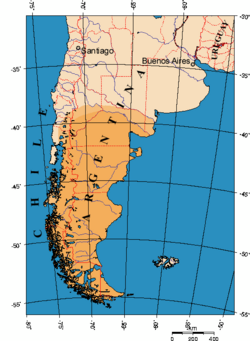Patagonia | |
|---|---|
 | |
| Area | |
• Total | 1,043,076 km2 (402,734 sq mi) |
| Population | |
• Total | 1,999,540 |
| • Density | 1.9/km2 (5.0/sq mi) |
| Demonym | Patagonian |
| Demographics | |
| • Languages | Rioplatense Spanish, Chilean Spanish, Mapudungun, Welsh |
Patagonia (Spanish pronunciation: [pataˈɣonja]) is a geographical region that encompasses the southern end of South America, governed by Argentina and Chile. The region comprises the southern section of the Andes Mountains with lakes, fjords, temperate rainforests, and glaciers in the west and deserts, tablelands, and steppes to the east. Patagonia is bounded by the Pacific Ocean on the west, the Atlantic Ocean to the east, and many bodies of water that connect them, such as the Strait of Magellan, the Beagle Channel, and the Drake Passage to the south.
The Colorado and Barrancas rivers, which run from the Andes to the Atlantic, are commonly considered the northern limit of Argentine Patagonia.[1] The archipelago of Tierra del Fuego is sometimes included as part of Patagonia. Most geographers and historians locate the northern limit of Chilean Patagonia at Huincul Fault, in Araucanía Region.[2][3][4][5]
At the time of the Spanish arrival, Patagonia was inhabited by multiple indigenous tribes. In a small portion of northwestern Patagonia, indigenous peoples practiced agriculture, while in the remaining territory, peoples lived as hunter-gatherers, traveling by foot in eastern Patagonia or by dugout canoe and dalca in the fjords and channels. In colonial times indigenous peoples of northeastern Patagonia adopted a horseriding lifestyle.[6] While the interest of the Spanish Empire had been chiefly to keep other European powers away from Patagonia, independent Chile and Argentina began to colonize the territory slowly over the course of the 19th and early 20th centuries. This process brought a decline of the indigenous populations, whose lives and habitats were disrupted, while at the same time thousands of Europeans, Argentines, Chilotes and mainland Chileans settled in Patagonia.
The contemporary economy of eastern Patagonia revolves around sheep farming and oil and gas extraction, while in western Patagonia fishing, salmon aquaculture, and tourism dominate.
- ^ The Late Cenozoic of Patagonia and Tierra del Fuego Volumen 11 de Developments in quaternary science, pág. 13. Autor: Jorge Rabassa. Editor: Jorge Rabassa. Editor: Elsevier, 2008. ISBN 0-444-52954-3, 9780444529541
- ^ Manuel Enrique Schilling; Richard WalterCarlson; AndrésTassara; Rommulo Vieira Conceição; Gustavo Walter Bertotto; Manuel Vásquez; Daniel Muñoz; Tiago Jalowitzki; Fernanda Gervasoni; Diego Morata (2017). "The origin of Patagonia revealed by Re-Os systematics of mantle xenoliths." Precambrian Research, volumen 294: 15–32.
- ^ Zunino, H.; Matossian, B.; Hidalgo, R. (2012). "Poblamiento y desarrollo de enclaves turísticos en la Norpatagonia chileno-argentina. Migración y frontera en un espacio binacional." (Population and development of tourist enclaves in the Chilean-Argentine Norpatagonia. Migration and the border in a binational space), Revista de Geografía Norte Grande, 53: 137–158.
- ^ Zunino, M.; Espinoza, L.; Vallejos-Romero A. (2016) Los migrantes por estilo de vida como agentes de transformación en la Norpatagonia chilena, Revista de Estudios Sociales, 55 (2016): 163–176.
- ^ Ciudadanía, territorio y desarrollo endógeno: resistencias y mediaciones de las políticas locales en las encrucijadas del neoliberalismo. Pág. 205. Autores: Rubén Zárate, Liliana Artesi, Oscar Madoery. Editor: Editorial Biblos, 2007. ISBN 950-786-616-7, 9789507866166
- ^ Cayuqueo, Pedro (2020). Historia secreta mapuche 2. Santiago de Chile: Catalonia. pp. 34–37. ISBN 978-956-324-783-1.